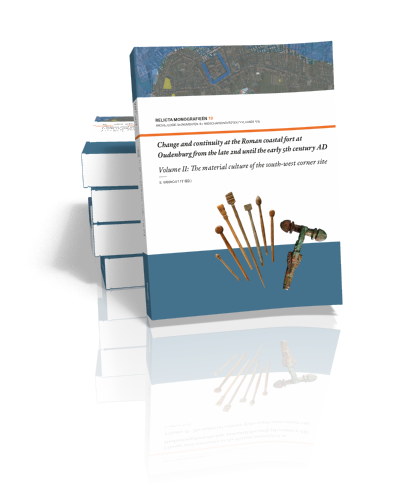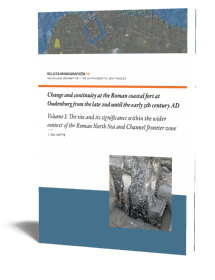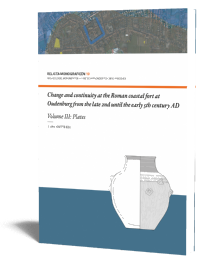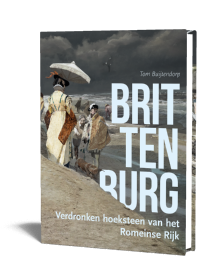Change and continuity at the Roman coastal fort at Oudenburg from the late 2nd until the early 5th century AD (Volume II)
The material culture of the south-west corner site
Edited by S. Vanhoutte | 2023

Change and continuity at the Roman coastal fort at Oudenburg from the late 2nd until the early 5th century AD (Volume II)
The material culture of the south-west corner site
Edited by S. Vanhoutte | 2023
Paperback ISBN: 9789464260861 | Hardback ISBN: 9789464260878 | Imprint: Sidestone Press | Format: 210x280mm | 604 pp. | Relicta Monografieën 19 | Language: English | 17 illus. (bw) | 144 illus. (fc) | Keywords: Roman archaeology; Roman forts; Roman military; Roman defence structures; Roman material culture | download cover | DOI: 10.59641/g6b75f98
Read online 291 times
- Digital & Online access
-
Buy via Sidestone (EU & UK)
-
Buy via our Distributors (WORLD)
For non-EU or UK destinations you can buy our books via our international distributors. Although prices may vary this will ensure speedy delivery and reduction in shipping costs or import tax. But you can also order with us directly via the module above.
UK international distributor
USA international distributor
-
Bookinfo
Paperback ISBN: 9789464260861 | Hardback ISBN: 9789464260878 | Imprint: Sidestone Press | Format: 210x280mm | 604 pp. | Relicta Monografieën 19 | Language: English | 17 illus. (bw) | 144 illus. (fc) | Keywords: Roman archaeology; Roman forts; Roman military; Roman defence structures; Roman material culture | download cover | DOI: 10.59641/g6b75f98
Read online 291 times

We will plant a tree for each order containing a paperback or hardback book via OneTreePlanted.org.
In the later Roman period the North Sea and Channel region was the scene of seaborne attacks, political crises, army reforms, Germanic invasions and changing imperial defence strategies. Literary evidence for this era is poor. On the other hand the Shore forts can yield highly significant information, but have been subject to little study in recent decades. At the Belgian coastal fort at Oudenburg large-scale excavations in the first decade of the 21st century revealed a strikingly well-preserved chronological, spatial and functional evolution of this military base, with five main fort periods running from the late 2nd until the early 5th century AD. For the first time within the context of the Shore forts securely datable structural evidence demonstrates the stages in progression of a mid- to late Roman fort where the horizons can be related to historically recorded processes and events in the region. Political, economic and social developments can be seen within this evidence, as a result of the assessment of the huge quantity of well-stratified finds types. Reports on the finds assemblage by specialist experts, using various analytical methods, represent ‘touchstones’ for regional military and later Roman studies in the North-West provinces.
The study of Oudenburg, and in relationship to other Shore forts, enables exploration of ‘change and continuity’ and ‘identity’, in respect of the everyday lives of soldiers, and in their interaction with other forts and wider regional spheres. This is achieved by examining find contexts as reflections of the socio-cultural world. The study of ‘military identities’ is further emphasized through looking at the associated graveyards wherein the direct relationship with the successive fort periods is established. It is clear this fort was closely connected with the British forts and that there occurred an increasing Germanic influence as the fort transformed into a community of military families.
This is volume two of three and provides detailed reports on the finds assemblage of the south-west corner site of the Oudenburg fort.
Also see:CHAPTER 1. The pottery
A. Imported fine wares
1. Samian wares
Sofie Vanhoutte, Wim De Clercq and Johan Deschieter
2. Colour-coated and black-slipped wares
Robin P. Symonds and Sofie Vanhoutte
3. Marbled wares
Robin P. Symonds
4. Fine oxidized wares
Sonja Willems
5. Mica-dusted wares
Sonja Willems
6. Pompeian red wares
Sonja Willems
B. Imported coarse wares
1. Amphorae
Patrick Monsieur and Sofie Vanhoutte
2. ‘Common’ flagon wares
Sofie Vanhoutte and Sonja Willems
3. Mortaria
Sofie Vanhoutte, Sonja Willems and Robin P. Symonds
4. Eifelware and other coarse oxidized wares
Sofie Vanhoutte
5. Reduced wares
Malcolm Lyne, Sonja Willems, Vince Van Thienen and Sofie Vanhoutte
C. Local and imported handmade wares
1. North Menapian handmade wares
Wim De Clercq and Sofie Vanhoutte
2. Late Roman (Germanic-style) handmade pottery
Vince Van Thienen
D. Local wheel-thrown wares
1. North Menapian grey wares
Sofie Vanhoutte and Wim De Clercq
2. Two large beakers with an Oudenburg-Aardenburg-Britannia link
Sofie Vanhoutte and Sonja Willems
E. The North Menapian pottery group. Reviewing an important 2nd- and 3rd-century local/regional ceramic industry
Sofie Vanhoutte and Wim De Clercq
CHAPTER 2. The coins
Sofie Vanhoutte and Johan van Heesch
CHAPTER 3. The metal finds
Sofie Vanhoutte, with a case-study on the crossbow brooches by Vince Van Thienen
CHAPTER 4. The items in worked animal products (antler, horn, bone and ivory)
Sofie Vanhoutte
CHAPTER 5. The jet and jet-like finds
Sofie Vanhoutte and Peter Cosyns
CHAPTER 6. The glass finds
Peter Cosyns and Sofie Vanhoutte
CHAPTER 7. The figurines
Jan De Beenhouwer and Sofie Vanhoutte
CHAPTER 8. The leather finds
Carol van Driel-Murray
CHAPTER 9. The ceramic building material
Tim R. Clerbaut and Sofie Vanhoutte
CHAPTER 10. The stone implements
Sibrecht Reniere
APPENDIX. The key context assemblages
Sofie Vanhoutte
BIBLIOGRAPHY

Dr. S. Vanhoutte
Sofie Vanhoutte is Heritage Researcher Archaeology at the Flanders Heritage Agency (Belgium). Since 2019 she is also teaching assistant at Ghent University. This publication is a further enlargement of her doctoral research ‘Change and Continuity at the Roman Fort at Oudenburg from the late 2nd until the early 5th century AD, with a particular focus on the evidence of the material culture and its significance within the wider context of the Roman North Sea and Channel frontier zone’, a joint PhD at the Free University of Brussels (VUB) and the University of Kent (Canterbury, UK). She defended her PhD successfully in September 2018.
Abstract:
In the later Roman period the North Sea and Channel region was the scene of seaborne attacks, political crises, army reforms, Germanic invasions and changing imperial defence strategies. Literary evidence for this era is poor. On the other hand the Shore forts can yield highly significant information, but have been subject to little study in recent decades. At the Belgian coastal fort at Oudenburg large-scale excavations in the first decade of the 21st century revealed a strikingly well-preserved chronological, spatial and functional evolution of this military base, with five main fort periods running from the late 2nd until the early 5th century AD. For the first time within the context of the Shore forts securely datable structural evidence demonstrates the stages in progression of a mid- to late Roman fort where the horizons can be related to historically recorded processes and events in the region. Political, economic and social developments can be seen within this evidence, as a result of the assessment of the huge quantity of well-stratified finds types. Reports on the finds assemblage by specialist experts, using various analytical methods, represent ‘touchstones’ for regional military and later Roman studies in the North-West provinces.
The study of Oudenburg, and in relationship to other Shore forts, enables exploration of ‘change and continuity’ and ‘identity’, in respect of the everyday lives of soldiers, and in their interaction with other forts and wider regional spheres. This is achieved by examining find contexts as reflections of the socio-cultural world. The study of ‘military identities’ is further emphasized through looking at the associated graveyards wherein the direct relationship with the successive fort periods is established. It is clear this fort was closely connected with the British forts and that there occurred an increasing Germanic influence as the fort transformed into a community of military families.
This is volume two of three and provides detailed reports on the finds assemblage of the south-west corner site of the Oudenburg fort.
Also see:- Change and continuity at the Roman coastal fort at Oudenburg Volume 1
- Change and continuity at the Roman coastal fort at Oudenburg Volume 3
Contents
CHAPTER 1. The pottery
A. Imported fine wares
1. Samian wares
Sofie Vanhoutte, Wim De Clercq and Johan Deschieter
2. Colour-coated and black-slipped wares
Robin P. Symonds and Sofie Vanhoutte
3. Marbled wares
Robin P. Symonds
4. Fine oxidized wares
Sonja Willems
5. Mica-dusted wares
Sonja Willems
6. Pompeian red wares
Sonja Willems
B. Imported coarse wares
1. Amphorae
Patrick Monsieur and Sofie Vanhoutte
2. ‘Common’ flagon wares
Sofie Vanhoutte and Sonja Willems
3. Mortaria
Sofie Vanhoutte, Sonja Willems and Robin P. Symonds
4. Eifelware and other coarse oxidized wares
Sofie Vanhoutte
5. Reduced wares
Malcolm Lyne, Sonja Willems, Vince Van Thienen and Sofie Vanhoutte
C. Local and imported handmade wares
1. North Menapian handmade wares
Wim De Clercq and Sofie Vanhoutte
2. Late Roman (Germanic-style) handmade pottery
Vince Van Thienen
D. Local wheel-thrown wares
1. North Menapian grey wares
Sofie Vanhoutte and Wim De Clercq
2. Two large beakers with an Oudenburg-Aardenburg-Britannia link
Sofie Vanhoutte and Sonja Willems
E. The North Menapian pottery group. Reviewing an important 2nd- and 3rd-century local/regional ceramic industry
Sofie Vanhoutte and Wim De Clercq
CHAPTER 2. The coins
Sofie Vanhoutte and Johan van Heesch
CHAPTER 3. The metal finds
Sofie Vanhoutte, with a case-study on the crossbow brooches by Vince Van Thienen
CHAPTER 4. The items in worked animal products (antler, horn, bone and ivory)
Sofie Vanhoutte
CHAPTER 5. The jet and jet-like finds
Sofie Vanhoutte and Peter Cosyns
CHAPTER 6. The glass finds
Peter Cosyns and Sofie Vanhoutte
CHAPTER 7. The figurines
Jan De Beenhouwer and Sofie Vanhoutte
CHAPTER 8. The leather finds
Carol van Driel-Murray
CHAPTER 9. The ceramic building material
Tim R. Clerbaut and Sofie Vanhoutte
CHAPTER 10. The stone implements
Sibrecht Reniere
APPENDIX. The key context assemblages
Sofie Vanhoutte
BIBLIOGRAPHY

Dr. S. Vanhoutte
Sofie Vanhoutte is Heritage Researcher Archaeology at the Flanders Heritage Agency (Belgium). Since 2019 she is also teaching assistant at Ghent University. This publication is a further enlargement of her doctoral research ‘Change and Continuity at the Roman Fort at Oudenburg from the late 2nd until the early 5th century AD, with a particular focus on the evidence of the material culture and its significance within the wider context of the Roman North Sea and Channel frontier zone’, a joint PhD at the Free University of Brussels (VUB) and the University of Kent (Canterbury, UK). She defended her PhD successfully in September 2018.
- Digital & Online access
-
Buy via Sidestone (EU & UK)
-
Buy via our Distributors (WORLD)
For non-EU or UK destinations you can buy our books via our international distributors. Although prices may vary this will ensure speedy delivery and reduction in shipping costs or import tax. But you can also order with us directly via the module above.
UK international distributor
USA international distributor
- Browse all books by subject
-
Search all books

We will plant a tree for each order containing a paperback or hardback book via OneTreePlanted.org.
You might also like:
© 2025 Sidestone Press KvK nr. 28114891 Privacy policy Sidestone Newsletter Terms and Conditions (Dutch)








